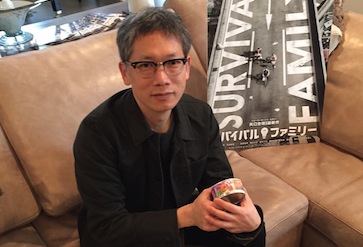
Chatsubo (Tea Jar)
In the world of Chad?, we have four guiding principles: harmony, respect, purity, and tranquility. Overtime, I have come to feel that these principles can be summed up with the simple phrase, ?Always do the most appropriate thing.? To accomplish this we must develop our sensitivity to the people we are with and the environment we are a part of. It would be a mistake to treat people and situations the same way. I think that we all do this naturally. We don?t greet our parents the same way we greet our friends. We don?t make Easter Eggs for Thanksgiving. It is the same with traditional Japanese culture. Sakura patterns are best for the spring and Hanabiramochi (a special sweet made with miso paste) is eaten only during beginning of the year. This attention to seasonal changes should not be seen as a bunch of oppressive rules but as opportunities to enjoy what is special about each moment. With that in mind, I would like to mention a few things about November.
Opening the ro
In the tearoom, we mainly use one of two sources of fire to heat the water. One is the furo. This is a ceramic, metal, or sometimes wooden vessel that sits on a board directly on top of the tatami mats. Inside, on a carefully arranged bed of ash, is where the charcoal fire is placed. Relatively speaking, the furo houses a smaller fire and is kept a little bit away from the guests. This helps keep the room cooler.
The other heat source is the ro. The ro is a fire pit cut into the floor between the host and the guests. The ash arrangement is courser and the fire is much larger. The ro is opened in early November with the start of winter. Opening the ro changes almost everything in the way we make tea, so much so that this time is often referred to as the “New Year” for tea.
After the ro has been opened the tatami mats are rearranged. The moss in the garden is covered with pine needles to protect it from the coming cold. The tatami are recovered and the paper on the shoji doors is replaced. A larger ladle is used to scoop the water from the large kettle of water in the tearoom. Even the manner of making tea changes since the host now sits slanted towards the guests, adding to that feeling of friends sitting around the fire. There is also great anticipation in the air as we finally get to enjoy this year?s tea. To make matcha, the leaves are picked, steamed, and stored in May. This new year?s worth of tea is aged and is not usually sold until November. Therefore, November?s tea is the freshest you will have all year. Nowadays, matcha is pre-ground but in the past, it was sold in the leaf form and sealed in ceramic jars by the tea growers. To be invited to a ?seal opening? tea gathering was and still is considered a great honor. A special feature of this Kuchi-kiri tea gathering is the viewing of the tea jar (chatsubo) and enjoying the distant sounds of the tea being freshly ground as you enjoy a meal of freshly prepared seasonal food.
Kigo
What we now consider the Japanese Tea Ceremony can be traced back hundreds of years, but there are ideas and practices that are far older. In fact, these ideas and practices are the foundation on which Chanoyu was built upon. One of the main ideas is the poetic appreciation of seasonal changes. In the eye of someone classical trained in Japanese sensibilities, the year is not divided by four seasons but by 24 distinct seasonal markers. Add to this the Asian theory of the five elements, yin and yang, the lunar calendar, and centuries of Chinese literature. All together you have a wealth of words and imagery that one would be expected to know and use when doing something like composing waka poetry (which gave birth to haiku). The poet?s skill is partially judged by his/her ability to use these seasonal references. In general, these words are known as kigo, short for kisetsu go, which means ?seasonal language.?? Kigo is used time and time again for the naming of tea utensils and in the poetry of the hanging scrolls. Although I am not an expert in matters of kigo, I am happy to share the little that I know with you.
Here are a just a few related to the month of November:
??? – shimofuri zuki | Frost falling month
??? – yukimachi zuki | The month of waiting for snow
?? – ritt? | This is the name for the first day of winter, around November 8th
?? – heiden | The flat and empty fields after the harvest.
by Omar Francis Sensei, instructor in the Urasenke Tradition of Chanoyu and Vice President of Chado Urasenke Tankokai Chicago Association











